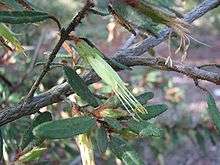Correa calycina
Correa calycina, the South Australian green correa, is a tall shrub which is endemic to South Australia.[1] It grows to between 1 and 3 metres in height and 1 to 2 metres wide. The leaves are glabrous to tomentose and are 2 to 4 cm long and 1 to 2.5 cm wide. The flowers are produced between April and September in their native range. These are green, sometimes maturing to mauve.[1]
| Correa calycina | |
|---|---|
 | |
| Scientific classification | |
| Kingdom: | Plantae |
| Clade: | Tracheophytes |
| Clade: | Angiosperms |
| Clade: | Eudicots |
| Clade: | Rosids |
| Order: | Sapindales |
| Family: | Rutaceae |
| Genus: | Correa |
| Species: | C. calycina |
| Binomial name | |
| Correa calycina | |
| Wikimedia Commons has media related to Correa calycina. |
Taxonomy
The species was first formally described in 1925 by J.M. Black in Transactions and Proceedings of the Royal Society of South Australia.[2]
There are two varieties which are currently recognised:
- Correa calycina J.M.Black var. calycina (Hindmarsh Correa) which is listed as a "vulnerable species" under South Australia's National Parks and Wildlife Act 1972.[3]
- Correa calycina var. halmaturorum Paul G.Wilson (De Mole River Correa)[4]) which was first formally described by Paul G. Wilson in the journal Nuytsia in 1998.[2]
References
- "Correa calycina J.M.Black". Electronic Flora of South Australia Fact Sheet. State Herbarium of South Australia. Archived from the original on 29 November 2012. Retrieved 21 August 2010.
- "Correa calycina". Australian Plant Name Index (APNI), IBIS database. Centre for Plant Biodiversity Research, Australian Government, Canberra. Retrieved 5 May 2009.
- "National Parks and Wildlife Act 1972 - Schedule B". South Australian Consolidated Acts. Retrieved 7 May 2009.
- "Biodiversity Assessment - Kanmantoo". Australian Natural Resources Atlas. Australian Government. Archived from the original on 22 August 2008. Retrieved 7 May 2009.
This article is issued from Wikipedia. The text is licensed under Creative Commons - Attribution - Sharealike. Additional terms may apply for the media files.